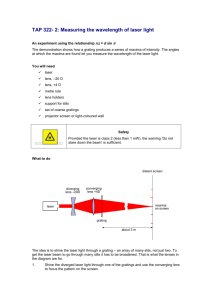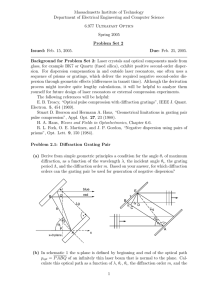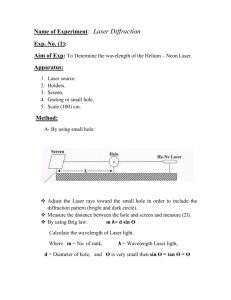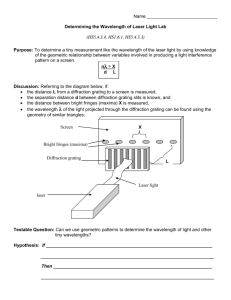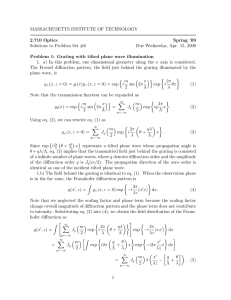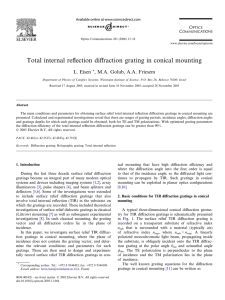Diffraction Grating
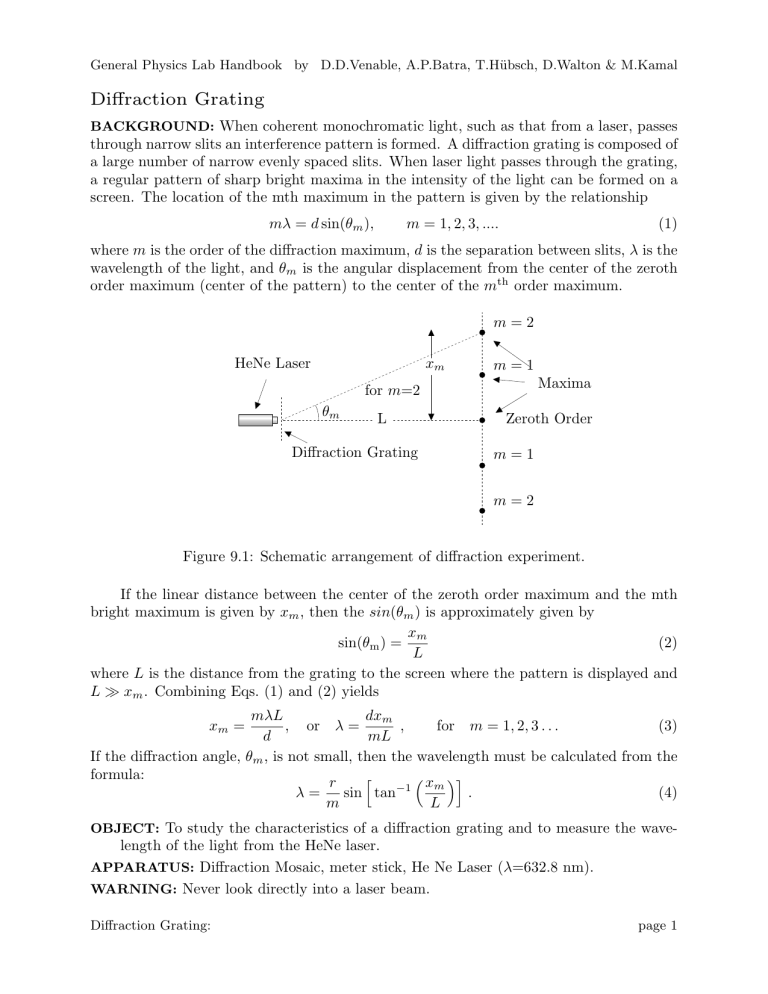
Diffraction Grating
BACKGROUND: When coherent monochromatic light, such as that from a laser, passes through narrow slits an interference pattern is formed. A diffraction grating is composed of a large number of narrow evenly spaced slits. When laser light passes through the grating, a regular pattern of sharp bright maxima in the intensity of the light can be formed on a screen. The location of the mth maximum in the pattern is given by the relationship mλ = d sin( θ m
) , m = 1 , 2 , 3 , ....
(1) where m is the order of the diffraction maximum, d is the separation between slits, λ is the wavelength of the light, and θ m is the angular displacement from the center of the zeroth order maximum (center of the pattern)to the center of the m th order maximum.
m = 2
HeNe Laser
θ m for m =2
L
L x m m
Diffraction Grating m = 1
Maxima
Zeroth Order m = 1 m = 2
Figure 9.1: Schematic arrangement of diffraction experiment.
If the linear distance between the center of the zeroth order maximum and the mth bright maximum is given by x m
, then the sin ( θ m
)is approximately given by x m sin( θ m
) = (2)
L where L is the distance from the grating to the screen where the pattern is displayed and
L x m
. Combining Eqs. (1)and (2)yields x m
= mλL
, or λ = d dx m mL
, for m = 1 , 2 , 3 . . .
(3)
If the diffraction angle, θ m
, is not small, then the wavelength must be calculated from the formula:
λ = r sin tan
−
1 x m
.
(4) m L
OBJECT: To study the characteristics of a diffraction grating and to measure the wavelength of the light from the HeNe laser.
APPARATUS: Diffraction Mosaic, meter stick, He Ne Laser ( λ =632.8 nm).
WARNING: Never look directly into a laser beam.
Diffraction Grating: page 1
Figure 9.2: The Di ff raction Mosaic.
PROCEDURE:
1.
Arrange the laser and di ff raction grating mosaic so that the mosaic is about 5m from a white wall in the laboratory. This wall will serve as the screen.
2.
Place the laser behind the Mosaic so that the beam is incident normal to the 100 lines/mm grating (grating in upper left corner of the Mosaic).
3.
Measure the separations between the zeroth order maximum and the 1st, 2nd and 3rd order maxima.
4.
Record these data in the data table and determine the value for the wavelength,
λ
.
5.
Compare your average calculated value of the wavelength to the given value for the HeNe laser.
6.
Repeat steps 3 and 4 for the 300 lines/mm grating (top center of Mosaic).
7.
Compare your average calculated value of the wavelength to the given value for the HeNe laser.
8.
Repeat steps 3 and 4 for the 600 lines/mm grating (top right of Mosaic).
9.
Compare your average calculated value of the wavelength to the given value for the HeNe laser.
Grating
100 d
1mm/100
L X m tan( θ m
)=X m
/L θ m
= tan
-1
(X m
/L) λ =dsin θ m
/m x
1
θ
1
= lines/mm x
2
θ
2
= x
3
θ
3
=
300 lines/mm
1mm/300 x x
1
2
θ
1
=
θ
2
=
600 lines/mm
1mm/600 x
3 x x x
1
2
3
θ
3
=
θ
1
=
θ
2
=
θ
3
=
Questions:
1.
Describe the differences observed in the diffraction patterns for the three gratings.
2.
Show that Eq. (2) is (or is not) a valid approximation when L>>x m
.
